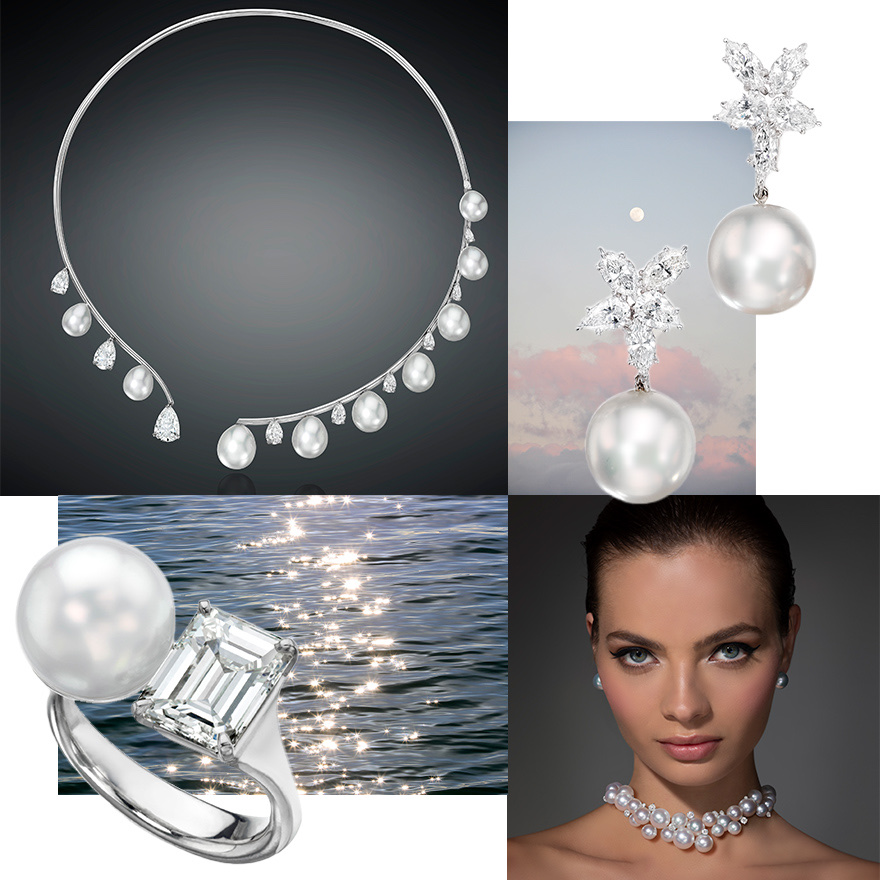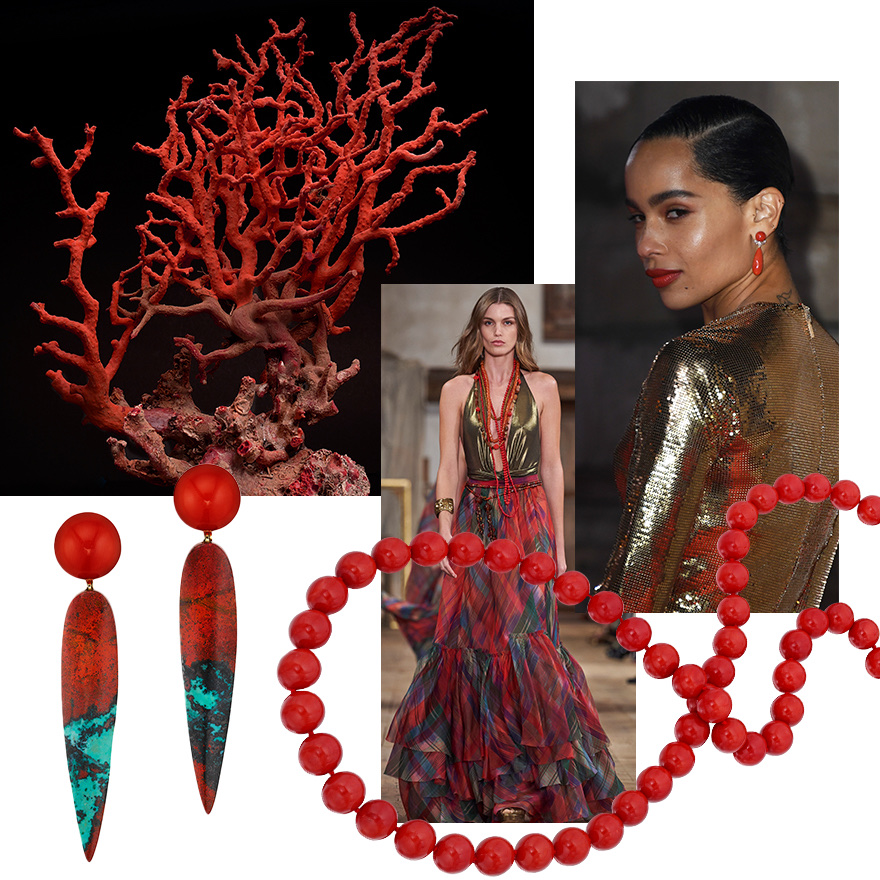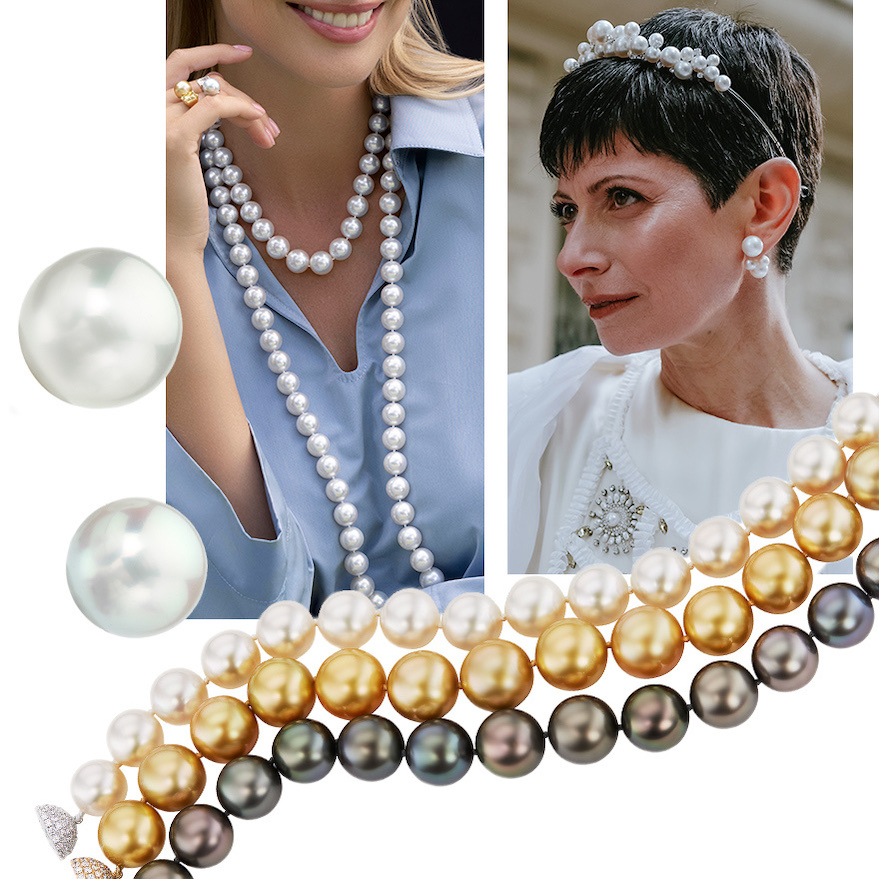
Frequently Asked Questions about Pearls – Answers to Top Pearl Questions from the Experts at Assael
Pearls come in a wide variety of types, shapes, colors, and sizes. Similar to the diamond’s 4Cs, there are also various criteria for assessing the pearl. This can sometimes lead to questions and common misunderstandings about pearls. Here, we tap the experts at the Assael team to answer some of the most common questions that people Google about pearls. For over 75 years, Assael has been leading the way in bringing the very highest qualities of pearls to the North American market. Pearl expertise is in the brand’s DNA. Who better to answer some of the most frequently asked questions about pearls?
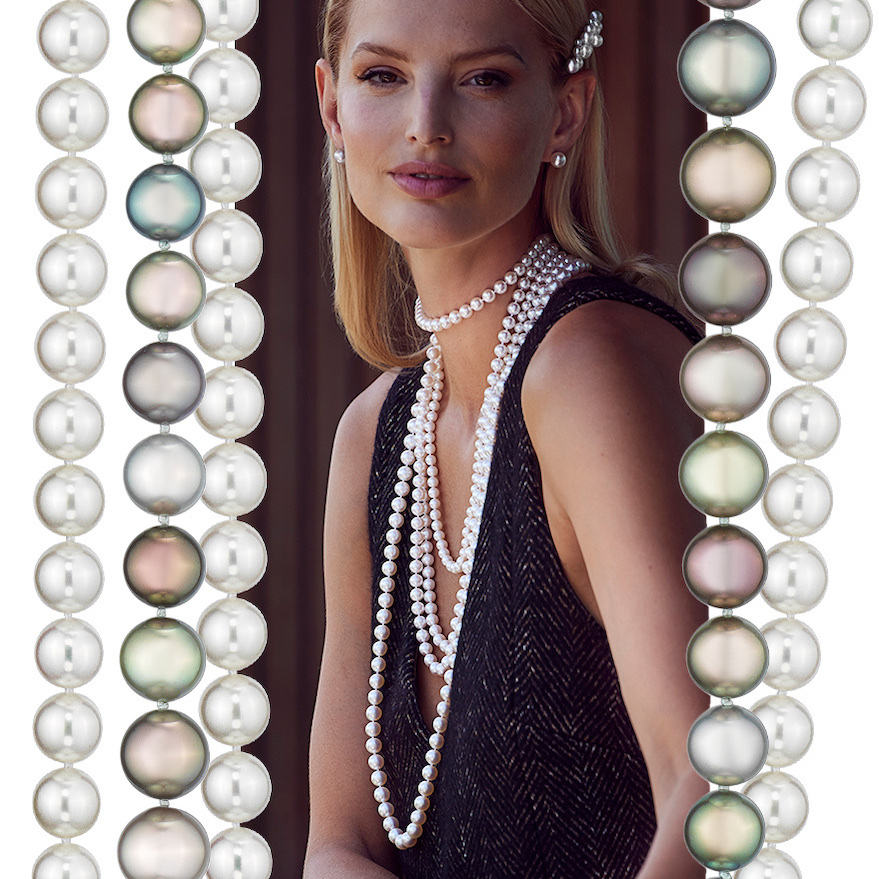
How Should I Care for My Pearls?
In order to maintain their beauty, pearls (and coral) should be worn frequently and handled with care. Protect your pearls in a suede or silk pouch and avoid contact with harsh chemicals like cosmetics, lotion, fragrance, chlorine, and bleach.
For more information, see our Pearl and Coral Care page, or our blog post on Travel Tips for the Pearl Obsessed.
What is a Cultured Pearl? Are Cultured Pearls Considered Real Pearls?
Cultured pearls are real pearls that have been cultivated and harvested in a pearl farm in the water (the ocean for saltwater pearls and rivers or lakes for freshwater pearls). To cultivate the pearls, pearl farming experts have purposefully inserted a nucleus into the oyster’s soft mantle tissue which thereby stimulates the oyster to form a pearl. The cultured pearl forms in its natural, organic process over time, but that process was initiated by human intervention which we commonly call “cultivation.”
For more information, see our blog posts on Pearls of Wisdom, and Introduction to Pearls – Understanding Nacreous and Non-Nacreous Pearls.
How Do You Know if Pearls are Real?
There are a few different ways to determine if a pearl is ‘real’ or fake, according to Jennifer Heebner, executive director of the Cultured Pearl Association of America (CPAA). “Because cultured pearls are formed by a mollusk in nature, most will have subtle imperfections in the form of surface bumps, dings, ridges, and imperfect (not round) shapes,” she says. Another giveaway is a slightly textured surface on nature-made pearls—this is where the imperfections come into play—that you can feel by running a pearl gently across a tooth.
Imitation pearls made by man can be completely smooth and will also likely be lighter in weight than a cultured pearl. Real cultured pearls have luster, sheen, and a mirror-like reflection in natural light, while factory-made pearls can have a dull, cloudy, or manufactured-looking surface that is ‘too perfect’ or uniform. Some faux pearl makers even mimic the baroque and off-round shapes of cultured pearls made in nature, but those silhouettes are homogeneous; every cultured pearl made by a mollusk is a one of a kind.
How To Assess the Value of Pearls?
Real pearls are pearls grown inside living oysters or mollusks. They are made up of nacre, the precious material that is also known as mother of pearl. Fake pearls are typically made of plastic, ceramic, or glass and are made in factories, not grown inside of oysters. When you lay them side by side, it is immediately obvious to the human eye which pearls are real. Luster is unmistakable.
For more information on assessing the value of pearls, see our blog posts on What Makes a Pearl Magnificent, Pearl Shopping 101 – 6 Things to Consider When Buying Pearls, How To Buy Pearls and Why Are South Sea Pearls So Valuable?
What is Nacre?
Nacre (pronounced NAY-kur), quite simply, refers to what is more commonly known as “mother of pearl.” It is the precious material that forms the bulk of most pearls – that beautiful, strong, radiant substance that gives the pearl its beloved and enduring luster. Generally speaking, the thicker the nacre in a pearl, the more luster the pearl will have and the more valuable the pearl will be.
For more information on Nacre, see our blog posts on What is Nacre?, Understanding Nacreous vs Non-Nacreous Pearls and Pearls of Wisdom.
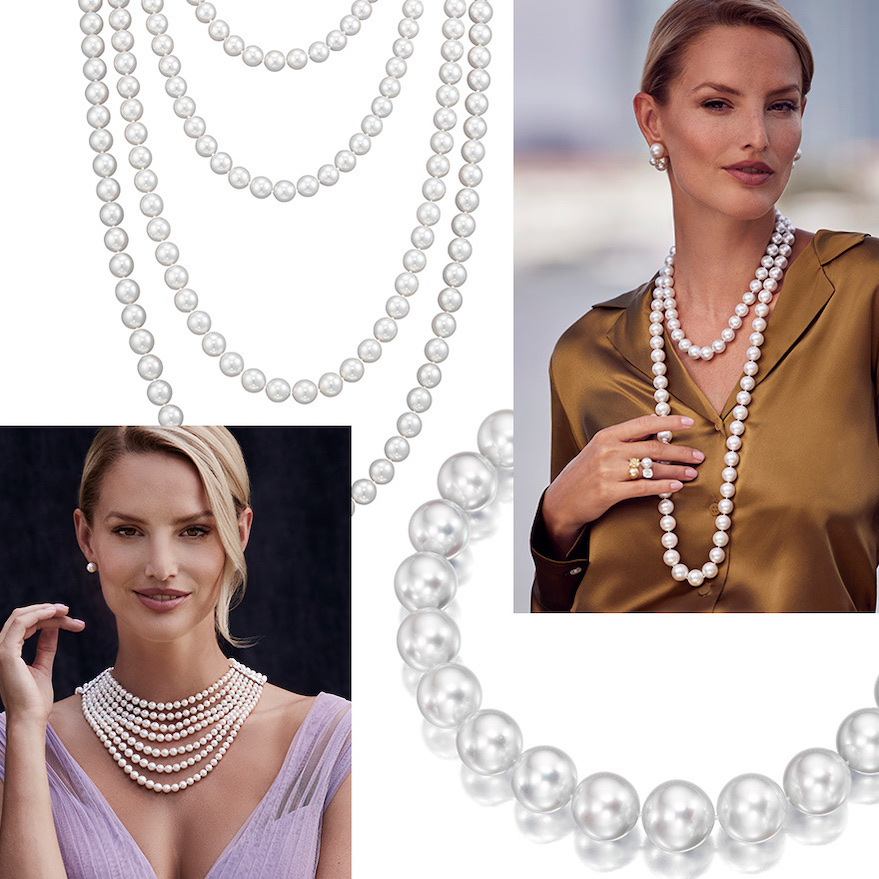
What are Akoya Pearls? or What is an Akoya Pearl?
Akoya pearls are saltwater cultivated pearls that come from the Japanese oyster of the same name. Akoya oysters (scientifically known as Pinctata Fukata) live off the coast of Japan and produce pearls that are highly prized because they have the highest luster of all pearls. Akoya pearls are usually round in shape and typically smaller in size than South Sea pearls, ranging from 2 mm to 10.5 mm.
For more information on Akoya pearls, see our blog posts on What is an Akoya Pearl? and Akoya vs South Sea Pearls.
What are South Sea Pearls? or What is a South Sea Pearl?
South Sea Pearls are cultured pearls that are literally harvested in the South Seas (parts of the world’s oceans south of the equator). Typically cultivated in pearl farms in the waters around Australia and Indonesia, South Sea pearls grow in the largest of all oyster species, the Pinctata Maxima. Because they grow in a larger oyster, South Sea pearls tend to be the largest of all cultured pearls, ranging in size from 8 mm to well over 20 mm.
For more information on South Sea Pearls, see our blog posts on Akoya vs South Sea Pearls, A Global Guide to South Sea Pearls, and South Sea Pearls – Large, Luxurious, and Long-Lasting.
Why are South Sea Pearls So Valuable?
South Sea Pearls are the largest of all cultured pearl varieties because they grow in the largest genus of oyster, the Pinctata Maxima. Similar to other precious gems (diamond, rubies, sapphires, and emeralds), larger pearls are more valuable if all other factors are equal, the same way that 2 carat diamond is more expensive than a 1 carat as long as the clarity, color and cut are similar. South Sea Pearls stay in the ocean for years to form, making the investment for pearl farmers quite expensive. The oysters must be cared for routinely throughout the process, adding many hours of labor and additional expense. The pearls also grow naturally inside the oysters while they are in the ocean, so there is very high risk for pearl farmers. If the oysters die or are affected by any unusual ocean conditions (pollution, global warming, tsunamis, etc.), the oysters cannot produce beautiful large pearls. Both the investment and the risks of pearl farming increase the cost of South Sea pearls. In addition to being larger than other cultured pearls, South Sea pearls also have incredibly high luster, and the gem quality pearls have very fine ratings in all of the pearl value factors (shape, nacre thickness, cleanliness of the surface, etc.). Pearls that rank very highly in all of these categories are going to be more valuable.
For more information on South Sea Pearls and their value/price, see our blog posts on Why Are South Sea Pearls So Valuable?
What is the difference between Akoya and South Sea Pearls?
Akoya pearls are grown in the Akoya oyster, a smaller variety of oyster that produces smaller pearls. South Sea pearls are grown in the largest of all oyster species and are typically much larger pearls. Akoya pearls are known for having the highest luster of all pearls, but very fine South Sea pearls also have incredibly high luster. The primary difference is size and origin– as a general rule Akoya pearls are smaller than South Sea pearls and Akoya pearls come from Japan mostly, while South Sea pearls come from the literal South Seas (south of the equator, off the coasts of Australia, Indonesia, and The Philippines). Another difference is shape – Akoya pearls are inherently round, whereas South Sea pearls can be round, off-round, drop shape or baroque (meaning not round, more organic in shape).
For more information on Akoya pearls, see our blog post on Akoya vs South Sea Pearls, as well as What is an Akoya Pearl?, Why Are South Sea Pearls So Valuable?, and South Sea Pearls – Large, Luxurious, and Long-Lasting.

What is a Tahitian Pearl? What is a Black Pearl?
Tahitian Pearls, sometimes called black pearls, are a special variety of cultured South Sea pearls that form inside the black-lipped oyster the Pinctata Margaritifera. This oyster is native to the waters around French Polynesia and Tahiti. The black mother of pearl or nacre secreted by these oysters forms beautiful dark pearls that can range in natural color from black and charcoal gray to olive green and magenta. Like all South Sea pearls, Tahitian pearls take years to form inside the oyster in the sea. The most highly prized Tahitian pearls are those with strong natural colors (no dyes), lovely shapes, high nacre thickness, and clean smooth surfaces.
For more information, see our blog posts on A Global Guide to South Sea Pearls or A Brief History of Tahitian Pearls.
What Should I Consider When Buying Pearls?
Most jewelry shoppers are familiar with the 4Cs for buying a diamond, but pearls also have important measures of quality. When shopping for pearls, it is important to understand how these factors affect the value of the pearls you are buying. Pearls are valued based upon their luster, size, shape, surface cleanliness, and color.
When buying pearl strands, it is important to consider millimeter size of the pearls (do you prefer or look better in smaller round pearls or large chunky baroque or off-round pearls), length (shorter or longer or multi-strand), color (white, cream, champagne, golden, Tahitian/black, etc.) and the type of clasp.
For more information, see our blog post on What Makes a Pearl Magnificent, Pearl Shopping 101 – 6 Things to Consider When Buying Pearls, and How To Buy Pearls or see our necklace/strand builder tool.
What is a Baroque Pearl? What Does Baroque Mean When Talking About Pearls?
Baroque Pearls are irregularly shaped or “imperfect” non-round pearls, and they come in almost all varieties of South Sea pearls. Their organic beauty captivates the attention, each unique shape more alluring than the next. These types of non-round pearls were first used in jewelry during the Baroque era, hence the name.
For more information, see our blog posts on Baroque South Sea Pearls & How to Wear Them or Imperfect Baroque Pearls are Perfectly Stunning.
What is a Keshi Pearl? What are Keshi Pearls
The keshi pearl forms as a by-product of cultivation and consists of nothing but pure nacre. Because nacre is precious material, keshi pearls are highly prized. For this reason, they are sold by weight like gemstones. All natural keshi pearls are unique treasures of rare and precious material. They form in unusual and organic shapes and can be very beautiful.
For more information, see our blog posts on Keshi Pearl Craze – For the Love of Luster, Keshi Couture – 3 Reasons Why Keshi Pearls are Pure Luxury

Clockwise from upper left – Assael Natural Purple Clam Pearl and Lavender Spinel ring, Rochas Women’s RTW (Launchmetrics Spotlight), loose pink natural conch pearls, loose orange natural Melo Melo pearls, more loose pink natural conch pearls, Spondylus “spiny” oyster shell
What is a Natural Pearl? What is the Difference Between Natural and Cultured Pearls?
Natural pearls are pearls that have formed with no human intervention, no nucleus inserted by a pearl farming technician. In the modern world, natural pearls of any variety are exceedingly rare. Today, most natural pearls are non-nacreous varieties like the highly prized Conch Pearls and/or Melo Melo pearls.
The difference between natural and cultured pearls is that the latter have been cultivated by mankind. Pearl farming experts purposefully insert a nucleus into the oyster’s soft mantle tissue which thereby stimulates the growing of a pearl. The cultured pearl forms in its natural, organic process over time, but that process was initiated by human intervention.
For more information, see our blog posts on Introduction to Pearls – Understanding Nacreous and Non-Nacreous Pearls or Rare Natural Pearls – A Guide to Non-Nacreous Pearl Treasures
What is a Conch Pearl? Why are Conch Pearls so Valuable?
A Natural Conch Pearl is an exceptional pink rarity produced by the Queen Conch (pronounced “conk”) mollusk, a large, edible sea snail found in the Caribbean. A single conch pearl is a genuine treasure, with only one found in every 10-20,000 shells. Of the few that are found, less than 10% are gem quality.
Not only are Conch Pearls rare in quantity, they also come in very unique shades, ranging from pink to watermelon translucence, and in rare cases with a visible, vibrant, flame-like pattern on the surface. That flame is often one of the most important determinants of value for a conch pearl, along with its shape, color, and size.
For more information, see our blog posts on Thinking Pink – Why Conch Pearls are So Much More Than Pretty or Rare Natural Pearls – A Guide to Non-Nacreous Pearl Treasures or Introduction to Pearls – Understanding Nacreous and Non-Nacreous Pearls
What is a Melo Melo Pearl? Why are Melo Melo Pearls so Valuable?
Melo Melo pearls are natural, non-nacreous, exceedingly rare calcareous concretions or masses of mineral produced by the marine gastropod species known as Volutidae—a large sea snail dubbed the melo melo. Like the animals that produce them, Melo Melo pearls are orange to tan to brown in color (with orange the choicest shade) and are found in the South China Sea and west to the Andaman Sea off the coast of Burma. The best specimens tend to come from Vietnam, and they can take up to ten years or more to form inside the sea snail. Melo Melo pearls do not contain nacre; instead, their composition is calcite and aragonite, giving them a fine glazed surface. Similar to conch pearls, those specimens with the highly prized flamelike patterns are the most valuable.
For more information, see our blog posts on Hello Melo – Learn What Makes This Vibrant Natural Pearl So Valuable or Rare Natural Pearls – A Guide to Non-Nacreous Pearl Treasures or Introduction to Pearls – Understanding Nacreous and Non-Nacreous Pearls
What is a Clam Pearl? What is a Quahog Clam Pearl?
Quahog Pearls come from clams as opposed to oysters or gastropods and therefore, they are often referred to as clam pearls. Quahog (pronounced KOH-hog) pearls occur in various colors. White is the least rare and often the most economical color, while purple to lavender colors are the rarest and most valuable. Other colors include beige, brown and black. Usually the more uniform the color, the higher the price.
For more information, see our blog posts on Rare Natural Pearls – A Guide to Non-Nacreous Pearl Treasures.
What is a Spondylus or Spiny Oyster Pearl?
Spondylus pearls do not come from gastropods. Instead, these non-nacreous pearls come from the Spondylus genus of bivalve mollusks, a specific type of oyster that has a spiny layer of protection along their outer shell. These oysters are more commonly known as “spiny oysters,” and occasionally (rarely), they produce natural non-nacreous pearls that are typically white to cream or various saturations of pink, orange, and brown. Spondylus pearls or spiny oyster pearls can also have distinctive features like the flamelike patterns found in the more well-known non-nacreous pearls like Conch and Melo Melo.
For more information, see our blog posts on Rare Natural Pearls – A Guide to Non-Nacreous Pearl Treasures.
Feature image at top – Clockwise from upper right – @lklevison wearing Bubble Tiara and earrings by Sean Gilson for Assael at the Save Venice Ball in NYC, photo courtesy of @thecuriouseyes, three strands of pearls – white Akoya pearls, Golden South Sea pearls, Tahitian pearls, loose South Sea pearls, model from “Elegance with Attitude” campaign (photographed by David Benoliel) wearing South Sea pearl strands in varying lengths with pearl and diamond rings
Posted on May 24, 2023 in Pearl Education by Duvall O'Steen
Articles you may also enjoy
Join our Mailing List
Join us for magnificent pearl trends and exclusive treasures. Discover a world that is truly ... beyond rare.

Feeling inspired?
Consider this your invitation to the House of Assael. Find your closest luxury jeweler using our map search and start your journey to timeless elegance.



